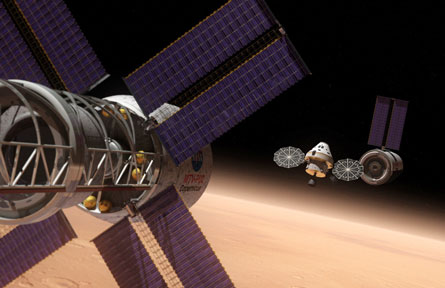Atom & Cosmos
NASA’s new old design for a shuttle replacement, plus Mars’ growth spurt, the most remote object and more in this week’s news
An old design for shuttle’s replacement
NASA has designated a successor to the space shuttle based on a design that was originally created to carry astronauts back to the moon, NASA Administrator Charles Bolden announced May 24. The space agency said it didn’t know when the proposed 23-ton vehicle, which could carry a four-person crew beyond low-Earth orbit for missions up to 21 days, would be ready to fly. With the space shuttle set for retirement in July, the agency will lack its own means to transport humans into space for at least several years and will reach the International Space Station by purchasing seats on the Russian Soyuz spacecraft. —Ron Cowen

New way to find habitable planets
Astronomers have discovered a method for verifying the presence of Earthlike habitable planets that otherwise would be too tiny to confirm. Francois Fressin of the Harvard-Smithsonian Center for Astrophysics in Cambridge, Mass., and his colleagues used NASA’s Spitzer Space Telescope to examine a candidate planet initially detected by Kepler spacecraft. The Spitzer observations show that the dimming of light from the sunlike star at infrared wavelengths is identical to that found by Kepler in visible light, confirming that a tiny planet, about 2.2 times Earth’s diameter, passed in front of the star. The newfound planet is too hot to contain liquid water, but the comparative technique can find cooler Earthlike planets, Fressin reported May 23 at a meeting in Boston of the American Astronomical Society. —Ron Cowen
Moon’s watery interior
Parts of the moon’s interior may contain as much water as in Earth’s upper mantle, a new study finds. Erik Hauri of the Carnegie Institution for Science in Washington, D.C., and his colleagues base the finding on primitive samples of lunar magma that retained water because they were trapped in crystals. The finding, reported online May 26 in Science, is surprising because it’s believed that the moon formed at high temperatures, when a Mars-sized body slammed into Earth. The hot, violent formation was thought to have caused most lunar water to evaporate. —Ron Cowen
Mars’ rapid buildup
Mars grew up in a hurry, reaching half its current size in no more than 1.8 million years, a new study finds. A team including Nicholas Dauphas of the University of Chicago came to that conclusion after examining data on isotopes of several heavy elements found in Martian meteorites. The rapid growth suggests that Mars accumulated its mass in isolation and that its supply of material was suddenly truncated. The study, reported in the May 26 Nature, also indicates that the Red Planet coalesced during a time when 100-kilometer-sized objects, such as asteroids, were still forming. —Ron Cowen
Distant contender
A short-lived stellar explosion seen two years ago may have come from the most remote object ever seen. Discovered April 29, 2009, the source of the gamma-ray burst lies an estimated 13.14 billion light-years from Earth. Combined with data on a slightly less remote burst found just six days earlier (SN Online: 4/28/09), the discovery suggests that the infant universe forged stars at a higher rate than had been estimated. Antonino Cucchiara of the University of California, Berkeley, reported the analysis May 25 at a meeting in Boston of the American Astronomical Society and in an upcoming Astrophysical Journal, putting the chances of the object being the most distant ever seen at 23 percent. A recently discovered galaxy might still be more distant, however (SN Online: 1/26/11). —Ron Cowen







